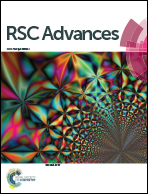Two-dimensional asynchronous spectrum with auxiliary cross peaks in probing intermolecular interactions†
Abstract
A new approach called “asynchronous spectrum with auxiliary peaks (ASAP)” is proposed for generating a 2D asynchronous spectrum to investigate the intermolecular interaction between two solutes (P and Q) dissolved in the same solution. In the ASAP approach, a virtual substance S with an isolated peak assumed to be at νS is introduced, while the characteristic peaks of P and Q are actually observed at νP and νQ. The concentrations series of P, Q and S are specifically designed so that a spectral portion that has nothing to do with the intermolecular interaction between P and Q is completely removed from the 2D asynchronous spectrum. Auxiliary cross peaks around (νP, νS) and (νQ, νS) can be used to reveal spectral variation caused by intermolecular interaction, which cannot be observed on conventional cross peaks appearing around the spectral coordinates (νP, νP), (νP, νQ), (νQ, νP), (νQ, νQ). For example, variation of the absorptivity of P caused by an intermolecular interaction between P and Q can be probed from the auxiliary cross peaks around (νP, νS) when Q does not even have any characteristic peak in the observed spectral range.


 Please wait while we load your content...
Please wait while we load your content...